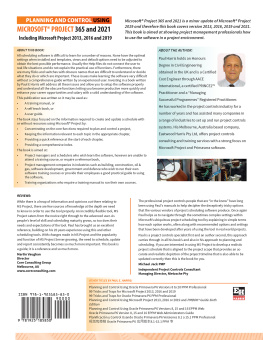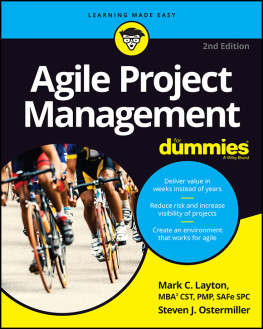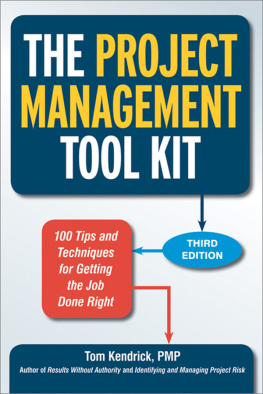
Copyright 2016 by Anna P. Murray. All rights reserved.
Published by John Wiley & Sons, Inc., Hoboken, New Jersey.
Published simultaneously in Canada.
No part of this publication may be reproduced, stored in a retrieval system, or transmitted in any form or by any means, electronic, mechanical, photocopying, recording, scanning, or otherwise, except as permitted under Section 107 or 108 of the 1976 United States Copyright Act, without either the prior written permission of the Publisher, or authorization through payment of the appropriate per-copy fee to the Copyright Clearance Center, Inc., 222 Rosewood Drive, Danvers, MA 01923, (978) 750-8400, fax (978) 646-8600, or on the Web at www.copyright.com. Requests to the Publisher for permission should be addressed to the Permissions Department, John Wiley & Sons, Inc., 111 River Street, Hoboken, NJ 07030, (201) 748-6011, fax (201) 748-6008, or online at http://www.wiley.com/go/permissions.
Limit of Liability/Disclaimer of Warranty: While the publisher and author have used their best efforts in preparing this book, they make no representations or warranties with respect to the accuracy or completeness of the contents of this book and specifically disclaim any implied warranties of merchantability or fitness for a particular purpose. No warranty may be created or extended by sales representatives or written sales materials. The advice and strategies contained herein may not be suitable for your situation. You should consult with a professional where appropriate. Neither the publisher nor author shall be liable for any loss of profit or any other commercial damages, including but not limited to special, incidental, consequential, or other damages.
For general information on our other products and services or for technical support, please contact our Customer Care Department within the United States at (800) 762-2974, outside the United States at (317) 572-3993 or fax (317) 572-4002.
Wiley publishes in a variety of print and electronic formats and by print-on-demand. Some material included with standard print versions of this book may not be included in e-books or in print-on-demand. If this book refers to media such as a CD or DVD that is not included in the version you purchased, you may download this material at http://booksupport.wiley.com. For more information about Wiley products, visit www.wiley.com.
Library of Congress Cataloging-in-Publication Data
Names: Murray, Anna, 1966- author.
Title: The complete software project manager : mastering technology from planning to launch and beyond / Anna P. Murray.
Description: Hoboken, New Jersey : John Wiley & Sons, Inc., [2016] | Includes index.
Identifiers: LCCN 2015036771 (print) | LCCN 2015040806 (ebook) | ISBN 9781119161837 (cloth) | ISBN 9781119219910 (ePDF) | ISBN 9781119219903 (ePub)
Subjects: LCSH: Computer softwareDevelopment. | Software engineering--Management.
Classification: LCC QA76.76.D47 M877 2016 (print) | LCC QA76.76.D47 (ebook) | DDC 005.1--dc23
LC record available at http://lccn.loc.gov/2015036771
Cover Design: Wiley
Cover Image: shuoshu / Getty Images
To my partner in life and business, Chris Moschovitis. Your support makes all things possible.
Foreword
A generation ago, Internet pioneer Carl Malamud took issue with people who complained about bulky computers, byzantine interfaces, and buggy software: A lot of this too hard to use stuff will go away. Radio was so messy for the first 20 years, it wasn't funny. Cars, dittoyou had to be a mechanic to drive one. Computers, he prophesied, would one day be as easy to use and reliable as automobiles had become, and the electronic frontier would become as simple to navigate as an Interstate with a road atlas.
That day came, of courseincluding Google Maps to replace the road atlasbut it brought along a paradox. The simplicity, power, and awesomeness that users and executives take for granted disguise the very technical, messy, and difficult work that happens behind the scenes. Gremlins lurk under the lid of your laptop; krakens crouch behind the scrim of your Cloud. A lot of what seems to gleam is the shimmer of WD-40 on duct tape.
Amateurs cheerfully rely on smoothly running software for business and pleasure, but the work of IT is no place for an amateur. Creating and designing systems, maintaining them, and running projects to install, fix, rip out and replace, upgrade, and integrate themthese are complicated tasks. They rarely go according to plan, because they invariably run into some obstacle that could not possibly be foreseen. Even professionals in the industry can be seduced by a project's progress into thinking, No problem, when they should be thinking, Oh, this is hairy. And, of course, finger-pointing is the consequence of problems, with IT blaming the business, the business blaming IT, and everybody blaming the consultants and software companies.
Anna Murray's book is an extraordinary accomplishment: It speaks as clearly to the IT professional as it does to executive civilians like me. (I'm an English major with a Mac.) For the professional, it is an experienced, no-nonsense guide: the mentor you wish you had. Anna tells you how to put an IT project into the strategic framework that is right for your organization, how to scope a project, how to communicate and plan with stakeholders; she tells you how to assemble your tools and team; she explains how to find, select, and manage vendors; and she tells you how to cook and eat crow when you need toas you almost certainly will.
The strategic point is particularly valuable. IT long ago migrated from the glass house to the desktop, but it is now part of every nerve and sinew of an organization: It is in the skin that touches customers, in the brain that analyzes performance, in the heart that pumps resources where they are needed. Technologists don't need to be strategists, but they can no longer be strategically ignorant. Anna shows how to connect strategy and IT, how to ask the right questions, and how to frame the trade-offs and decisions that complex IT projects require in a way that business leaders can understand.
This is, at the same time, the book IT managers should give to their nontechnologist colleagues, bosses, and internal customers. Her distinction among IT projects that are simple, complicated, and complex is worth the price of admission by itself. I can think back to half a dozen cases where the business-IT relationship got into trouble because the nontechnologists did not know or could not understand what their IT colleagues were up against. Any executive who reads this book will ask better questions, get better answers, and have a better understanding of the answers.
Thomas A. Stewart
Executive Director, National Center for the Middle Market
Fisher College of Business
The Ohio State University
Acknowledgments
This book grew out of a two-decades-long conversation with my colleagues and with the many clients we are privileged to serve. Starting back in the Windows 3.1 days, we have grappled with the complexities of technology and survived the numerous inevitable crises that accompany software development. My work has provided me with incredible opportunities to collaborate with and learn from these exceptional professionals.
I am grateful for Denise Mitchell and Rebecca Harrigan, incomparable technology leaders, partners, and clients, and for the great team at Kellogg Corporation. Also, for the executive group and the great IT, BA, and PM teams at Harvard Business Publishing. I also owe a debt of gratitude to my own team, from whom I am always learning: Frank G. Andrews, Pedro Garrett, Atsushi Tatsuoka, and Steve Vance.
Next page









